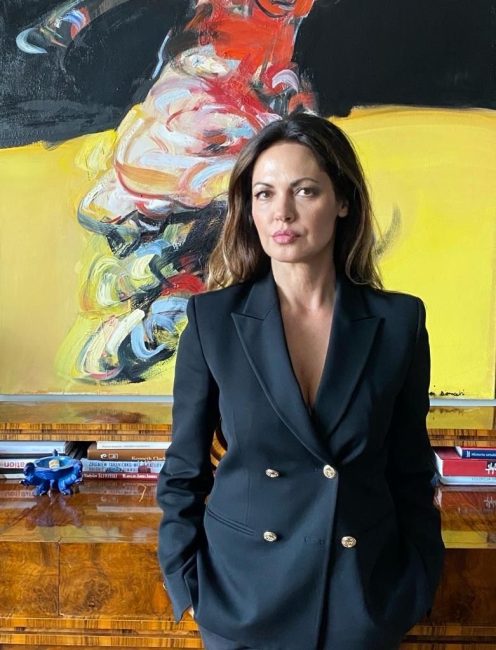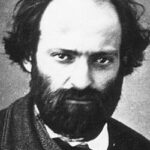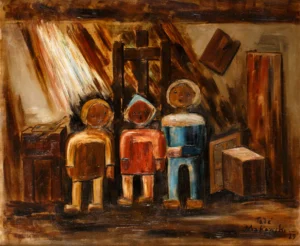Tadeusz Makowski (1882–1932)
The lonely poet of painting who transformed Cubism into a childlike metaphor of the world.
-
Style and technique: Started with academic landscape painting, later influenced by Cubism (during his stay in Paris), but eventually developed a unique style of fairy-tale realism — blending geometry with naive poetry. Mainly painted in oil, using delicate color transitions and soft contours.
-
Themes: Children, play, fairs, carolers — a world seen through a child’s eyes, yet filtered through melancholy and solitude.
-
Secrets and curiosities:
-
Lived most of his life on the margins of French bohemia — poor, misunderstood, but devoted to painting until the end.
-
Kept poetic notebooks in which he analyzed his paintings as living beings.
-
His works are today found in collections such as the Louvre and the Paris Bibliothèque nationale.
-
-
What does it tell us today? Art of childhood need not be childish. Makowski proved that deep truth about humanity lies in a childlike gaze.
 Joanna Piotrowska - Art Advisor & Marszand
Joanna Piotrowska - Art Advisor & Marszand
Biography
Tadeusz Makowski was a Polish painter associated with the School of Paris, known for his unique blend of cubism, Polish folk art, and naïve art influences. He studied philology and art in Kraków before settling in Paris, where he developed a style characterized by depictions of carnivals, fairs, children, and landscapes.
Early Life and Education
Born in Oświęcim, Poland, Makowski studied classical philology at Jagiellonian University and concurrently attended Kraków Academy of Fine Arts. He was taught by Jan Stanisławski and Józef Mehoffer. After completing his studies in 1908, he moved permanently to Paris.
Artistic Development
Initially influenced by his professors' styles, Makowski's exposure to cubist artists in Montparnasse, led by Henri Le Fauconnier, significantly shaped his work. During World War I, he spent time in Brittany, which inspired a turn away from strict cubism toward stylized natural subjects.
Themes and Style
Makowski favored subjects such as carnivals, fairs, and children, rendered in a style inspired by Old Dutch Masters, Polish folk art, and naïve art aesthetics. He also worked as a book illustrator using woodcuts.
Later Career and Legacy
During the 1920s, Makowski briefly lived in the Netherlands. He kept a diary from 1912 to 1931, published posthumously. His works are recognized for blending international avant-garde styles with Polish folk influences, contributing uniquely to the School of Paris.
Nationality
Polish
Categories
Painter, Painting
Themes
Carnivals, fairs, children, stylized landscapes, Polish folk art, naïve art
Art works
Girl with a Basket of Fruits and a Lamb, 1923
- Artist: Tadeusz Makowski
- Year: 1923
Girl with Chicks, circa 1923-27
- Artist: Tadeusz Makowski
- Year: ok. 1923-27
Boy with a Bird
- Artist: Tadeusz Makowski
- Year:
Children at the Table, 1929
- Artist: Tadeusz Makowski
- Year: 1929
Girl, 1920s
- Artist: Tadeusz Makowski
- Year:
Portrait of a Girl in a Hat, circa 1922
- Artist: Tadeusz Makowski
- Year: ok. 1922
Children, 1931
- Artist: Tadeusz Makowski
- Year: 1931
Landscape from Normandy, circa 1926-27
- Artist: Tadeusz Makowski
- Year: ok. 1926-27
Still Life with a Glass and Apples, 1915
- Artist: Tadeusz Makowski
- Year: 1915
The Studio L’atelier
- Artist: Tadeusz Makowski
- Year:
Artists
- Alfred Lenica
- Amedeo Modigliani
- Andrzej Wróblewski
- Andy Warhol
- Claude Monet
- Diego Velázquez
- Edouard Manet
- Edvard Munch
- Edward Dwurnik
- Ewa Juszkiewicz
- Franciszek Starowieyski
- Gerhard Richter
- Gustav Klimt
- Henri Matisse
- Henryk Stażewski
- Jackson Pollock
- Jan Berdyszak
- Jan Dobkowski
- Jan Lebenstein
- Jan Tarasin
- Jan Ziemski
- Jean-Michel Basquiat
- Jerzy Duda-Gracz
- Jerzy Nowosielski
- Jerzy Tchórzewski
- Kiejstut Bereźnicki
- Leon Tarasewicz
- Leonardo da Vinci
- Magdalena Abakanowicz
- Mark Rothko
- Pablo Picasso
- Paul Cézanne
- Peter Paul Rubens
- Pierre-Auguste Renoir
- Rembrandt van Rijn
- Rene Magritte
- Roman Opałka
- Roy Lichtenstein
- Ryszard Winiarski
- Sandro Botticelli
- Stefan Gierowski
- Tadeusz Kantor
- Tamara Lempicka
- Vincent van Gogh
- Wojciech Fangor
- Zdzisław Beksiński

















